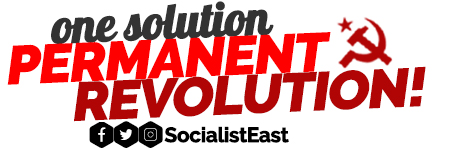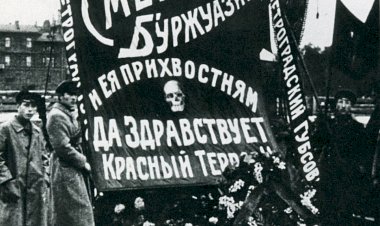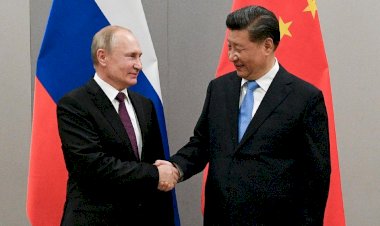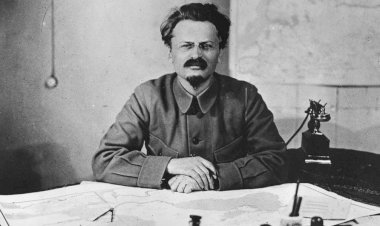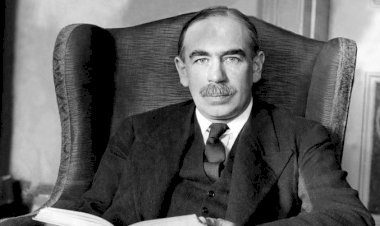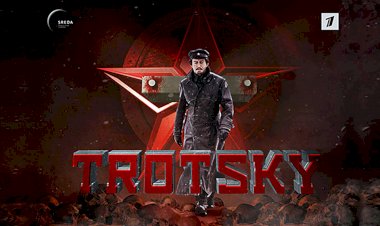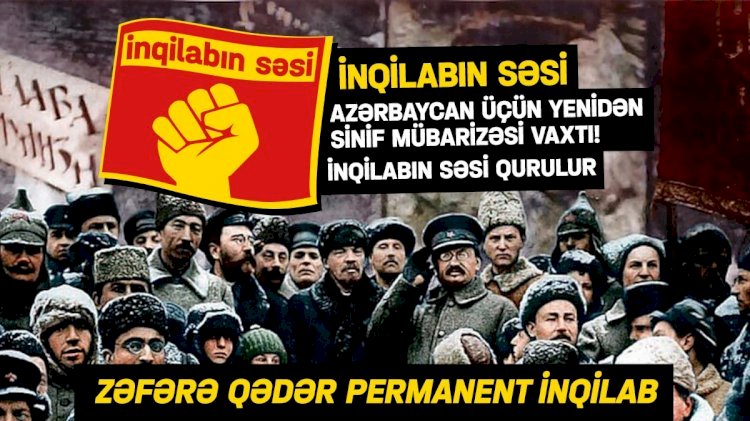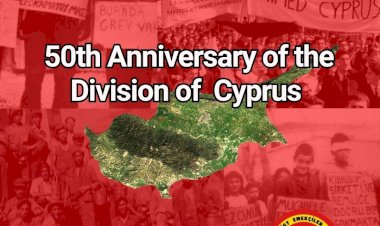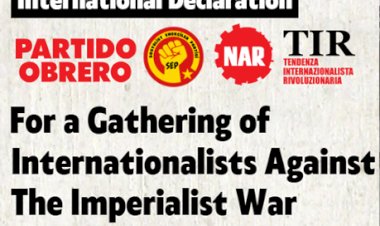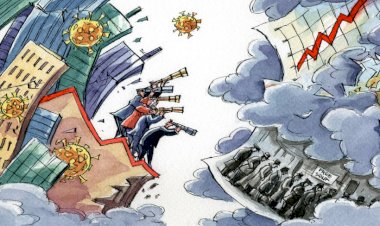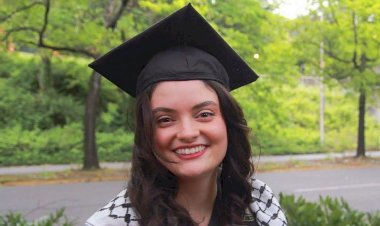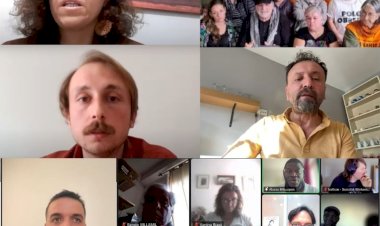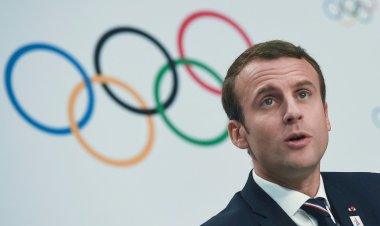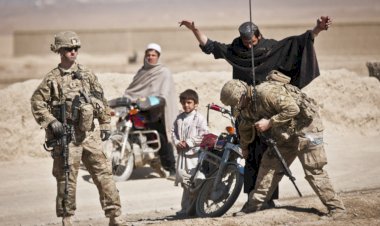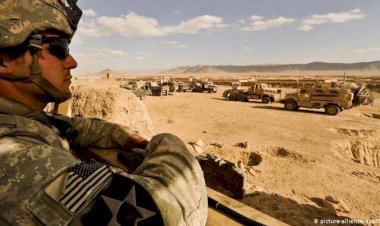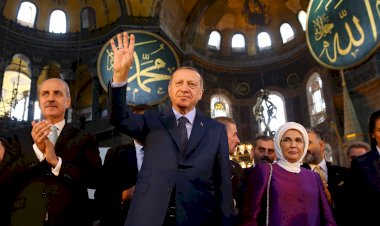Critique of the Theory of Deflected Permanent Revolution
Tony Cliff (1917-2000) has a special place among the new generation leaders who continued the revolutionary Marxist tradition after Trotsky. His distinctness bases on his insistence on critical thinking. Unlike the other leaders, Cliff, criticized some ideas of Trotsky. One of the distinctive work of Cliff is his critique of Trotsky’s definition of Russia as degenerated workers’ state which is not correct anymore. Cliff was not the only person who came to this conclusion but he was the only person who came to this conclusion and also adopted Trotsky’s legacy and continued establishing a socialist tradition at the same time. Cliff’s “State Capitalism in Russia” and biography of Lenin became very basic books for the education of new generation revolutionary Marxist cadres.
It is true that Trotsky left some blank in his analysis of the USSR because the rise of the Stalinist bureaucracy and collapse of the revolution from the inside are unique phenomenons in the history. The counter-revolution did not result from the bayonet of the White Army or the victory of the propertied classes and imperialism. When a fraction get organized in CPSU and betrayed the revolution, it could do this only by using the basic symbols (the flag, the name) of the state. And it did so until 1991. Therefore, it is not surprising that Trotsky was defending the gains of the October revolution and claiming these gains were still relevant in 1920’s when he was theorizing the counter-revolution, which became definite in late 1920’s. Trotsky, who was under the extreme pressure of the extraordinary events and the parties, had to give urgent responds to questions, which caused big changes in the balances. Despite these unfavorable conditions, Trotsky became the first person who voiced a systematic and coherent critique of bureaucratism. Over the years, he gave more severe and fundamental critique of the Stalinist rule. Unfortunately, as Trotsky was assassinated, he could not have the chance to complete some deficiencies in his analysis. Despite, only Trotsky could build a systematic and influential program of the revolutionary opposition. It is true that some parts of this construction may need revisions but this great work belongs to Trotsky.
What Cliff tried to do is to redact some parts of his maters’ works. This was an enormously important task because the leaders of the Fourth International after Trotsky were trapped in a dogmatism and only repeating the same words. Trotsky was the master of using the dialectic method in theory and the practice and this method which always requires not abandoning critical thinking. Yes, Cliff did not abandon the critical or dogmatize him like a prophet. Marxist methodology requires an effort to explain the life without any hesitation. However, this does not mean that critical method is always used properly. For example, Cliff made an important contribution when he asserted that the USSR is not a degenerated workers’ state but it is state capitalism. However, we cannot ignore important weaknesses in his pamphlet “Deflected Permanent Revolution”[1] in which he rejected the most vital parts of the theory of permanent revolution. In this work, he falls further behind of Trotsky and his ability to analyze and make abstraction.
The Questions Cuban Revolution Raised
Cliff authored Deflected Permanent Revolution pamphlet in 1963. Only months before the pamphlet was printed, the USSR located nuclear warhead missiles on Cuba and caused the biggest crisis of the Cold War. This event was an indication of that Castro and his cadres went into the orbit of the USSR. After that, Castro forgot all his previous critics about communism, which was only an identical category of Stalinism for him, and started to declare himself a communist in 1961 December. The mode of production of Cuba was reorganized in parallel with the USSR model: a planned economy, state ownership and a bureaucratic organization of the government from top down.
So, weren’t it the guerrillas who make the revolution? Weren’t Castro and his organization, 26th of July Movement is movement, petty bourgeois movement which tried to gain the support of peasants in the rural just like the all guerilla organizations in the world? Did not this situation, shake the foundations of the theory of permanent revolution? According to the theory of permanent revolution, the engine power of society is the working class but wasn’t it the petty bourgeois movement who make the revolution in Cuba? The answers given to these questions were decisive.
Some Trotskyist currents, who claim to stand in the tradition of the Fourth International, said that planned economy and state ownership of the property is enough to call the Cuba as a workers’ state (altough it is degenerated). So, the theory of permanent revolution is still relevant in Cuba[2]. For them, Castro and his comrades are the followers of permanent revolution unwittingly. This position opened the door of guerrillaism closed the door on proletarian revolutionary program. The US Socialist Workers’ Party (SWP) and the European-based International Secretariat of the Fourth International (ISFI), two of the parties of the previous international division in the Trotskyist movement, decided to reunite due to their absolute support for the Cuban Revolution. The emerging USFI (United Secretariat of the Fourth International International) became the pioneering force in Trotskyism over time, backing up to middle-class reactions from guerrillaism to identity politics. On the other hand, the proximity of SWP in the US to the Cuban government has reached such a point that the SWP made its transition to Castroism in the early 1980s and dissolved itself. Why do they need for Trotskyism, Bolshevism, and even working class revolutionism, if a group of guerrillas are able to carry out the permanent revolution? Such a dramatic end for a big tradition! This experience reveals how vital ideological strength is.
Unlike the US SWP, Cliff had a firm immunity to the attraction of Castroism because he did not think that Cuba was a workers’ state. Cliff, on the contrary, he embarked on an ideological struggle against the Trotskyists who critisized Castro by defending the slogan “the liberation of the working class will be his own work”. But condemning the Castro regime around the theory of state capitalism was only a part of the problem. On the other hand, it was necessary to explain the relation between the Cuban Revolution and the permanent revolution. After all, the theory of permanent revolution clearly explains the roles of the classes and their roles in backward countries. Apparently, what happened in Cuba was pointing to a middle-class revolution and this was a development that “falsified” the theory of permanent revolution.
Classes and Permanent Revolution
At the beginning of the 20th century, the footsteps of wars and revolutions were heard. The question was the character of revolution in countries outside of the developed areas of the world, which are only the US and some northeastern European countries. The expectation was to eliminate the barriers to the development of productive forces by the elimination of feudal forces, make a rapid industrialization, enforcement of constitutional rights, the formation of trade unions and strong parliament etc. through the bourgeois democratic revolutions. But would the revolutionary workers’ movement, which was expected to participate in that democratic revolutions with its massive power and general strike weapon, limit itself to this program?
In the last century, Russia was the country where this problem was put forward most seriously. On the one hand, there was a concentrated and radical workers’ movement; on the other hand, there were the peasant majority, weak bourgeoisie, rotten autocracy, nobles, church and even archaic social forms living on that backward gigantic lands. On that days, the leadership of the 2. International, who adopted a very mechanic and economic-determinist interpretation of Marxism, asserted that all the backward countries should “inevitably” experience a stage of democratic revolution. According to the theory stagism, the socialist revolution could not be on the agenda in less developed capitalist countries. This was like an official view of Marxism at the time, and accordingly the Mensheviks and even the Bolsheviks (until April 1917) did not proposed the program of socialist revolution for the workers’ movement.
Trotsky reached different conclusions. For him, the program of democratic revolution could not explain life. The era of bourgeois democratic revolutions, which was expected to abolish the feudal remains, solve the land and national questions , guarantee a constitutional democratic system, had already passed away. Although the bourgeoisie hated the privileges of the monarchy, it would never dare to cooperate with the radicalism of the lower classes. Because lower class radicalism was extremely dangerous and frightening for them. No one could predict where it would go or when it unleash the riffraff. The bourgeoisie knew that capitalist property would be put on the target.
Indeed, the organized working class and the poor people did not have any interest to stop the revolution they led after they overthrew Tsarism, landlords and churches and stay in the limits of democratic bourgeois revolution? Why would not they end exploitation, seize social wealth, and leave the power to the bourgeoisie on a silver platter? Moreover, according to the theory of stages, the distribution of the land to the peasants, the main task of the democratic revolution, would cause a decisive conflict with the propertied classes inevitably. At this point, Trotsky explained that even the narrow program of the democratic revolution would necessitates the defeat of all propertied classes. In other words, the ruling classes will unite against the workers and peasants against an attack to the big landowning due to the intertwining of the interests of aristocracy and the bourgeoisie. In other words, those who want to carry out a land reform must take the risk of a civil war. If you risk a civil war, you have to break the power of the classes with big property. In other words, the revolutionary dictatorship must not only seize the land, but to perpetuate this step, for example, it must seize the banks too. At this point, the revolution goes beyond the limits of a democratic revolution and socialist revolution starts. The main arteries of economy, which determine the country’s fate, must be taken under the control of the working class. The working class becomes the leader of society by pursuing the peasants, the poor people and the impoverished middle classes. This revolution forms only the beginning of an international revolution, and it has to spread. This is the only way to establish the workers’ power in an underdeveloped country, and it is not a dream. The crisis of the capitalist system are global and the revolutions are successive. With the spread of successful revolutions to different countries, it will be possible to defeat imperialist capitalism ultimately that is the material potential of establishing a communist world.
So, we can summarize the composition of classes in the theory of permanent revolution as follows:The bourgeoisie, who appeared late on the stage of history, is weak; it is deeply dependent to the monarchy, feudal residues and imperialist forces. Therefore, it is the enemy of the working people and terrified by revolutions. So bourgeoisie has no ability to carry out the program of bourgeois democratic revolutions.
Even when the proletariat is a minority in society in backward countries it still has the abilities to unite the poor sectors of society around its own program to be the revolutionary leader of nation. With its organized power, which is concentrated in industrial and commercial centers, the working class can bring the system to its knee. Moreover, elimination of the feudal and imperialist barriers to social development can only be possible through the establishment of workers’ power.
The peasants and other strata of the middle classes support the program of either the bourgeoisie or the working class because of the intermediate position of the petty bourgeoisie. They cannot play their own independent roles. When the proletariat unites under the leadership of the revolutionary party, the poor and landless peasants follow the revolutionary proletariat, so do the majority of the middle class intellectuals and semi-intellectuals. If the proletariat fails organize them, the sectors of petty bourgeoisie quickly join the ranks of the bourgeoisie.
Explaining Cuba and China
After roughly summarizing the position of classes in the theory of permanent revolution, we can begin discussion on the interpretation of the Cuban Revolution. Cliff’s interpretation of the Cuban Revolution is based on the general view on the left that the Cuban revolution is guerrilla revolution. Correspondingly, Cliff explains the transition to a nationalized and planned economy in Cuba as a middle class leadership, which eliminated feudal and imperialist barriers to social development. “A case in which neither the working class nor the peasantry played a serious role, but where middle-class intellectuals filled the whole arena of struggle, is Fidel Castro’s rise to power.”[3] A considerable part of the pamphlet is devoted on the efforts to prove that the role of the working class and the cities was insignificant in the Cuban Revolution. To support his ideas, Cliff makes quotations, give evidences, just like a guerrilla sympathizer trying to justify “foquism“. In fact, the people Cliff give reference to support his pro-guerilla ideas are either guerrilla leaders or uncritical supporters of them. According to these myth creators, including Cliff, the Cuban Revolution took place through the actions of heroic guerrillas. However, in 1956, the Castro-led team, which departed from Mexico and landed on Cuba, was only a group of 82, and in the first raid, only 12 survived and could participate in the struggle in the Sierra Maestra. Even in April 1958, there were only 180 guerrillas and they were only 803 on the day when Batista fell. In other words, the revolution cannot be understood without taking into account the key roles played by the cities, especially Havana, in the Cuban Revolution. The portrait of Cuban revolution, presented as if there were no strikes, no general strikes, no barricades, no clashes and student protests and in the following years, this portrait became a delusive revolution model for the youth[4]. It is surprising that Cliff denies the decisive role of the Cuban working class in the formation of the pre-revolutionary situation and the collapse of the regime. Cliff does this because the primary starting point in the Deflected Permanent Revolution pamphlet is to assert that passivity of working class in the underdeveloped countries paved the way for leadership of the middle class groups, which have capacity to lead revolutions. Cliff concluded that, apart from Cuba, the theory of permanent revolution also could not explain the Chinese Revolution, which was achieved through the pioneering and founding role of Mao-led guerrillas in establishing a Stalinist USSR-type regime. According to Cliff, the theory of permanent revolution can explain the Russian Revolutions in 1905 and 1917 and the 1926 in Chinese revolution, but not the revolution of 1949 in China and of 1959 in Cuba. In China and Cuba, the rotten aristocratic ruins and the weak bourgeoisie, which hindered the social development, were eliminated by the middle class intellectuals not by a revolutionary working class. Therefore, the theory of permanent revolution is “deflected” in these countries.
While Cliff constantly tries to explain why the theory of permanent revolution is ‘deflected’, he raises two basic “facts”. Firstly, Cliff asserts to explain that the working class is not revolutionary in all cases, and there are strong historical factors that blur its class-consciousness and organizational abilities. Therefore, in underdeveloped countries, in most cases, the working class is not in a position to lead the society politically. Since the bourgeoisie is fickle, manipulative and incapable (according to Cliff, the theory of permanent revolution is right in this regard!) to lead any social revolution. Therefore, the social contradictions waiting to be solved, do not remain as they are. At this point, middle class intellectuals step in to untie this node and the great historical contradictions are resolved by the revolution driven by the middle class intellectuals. After reaching these conclusions, Cliff provides in-depth and unoriginal explanations of the special position of middle-class intellectuals in societies.
It is a surprising “discovery” that the working class was not revolutionary in all cases and this “discovery” presented as an objection to the theory of permanent revolution. In fact, it is more surprising that it was Cliff who made this ridiculous objection to the theory of permanent revolution. Of course, the working class is not revolutionary in all cases. Throughout the history of capitalism, the periods in which working class makes revolutionary advances and the periods in which working class have regressions followed one after the other. The theory of permanent revolution describes the working class as the only revolutionary class and demonstrates its potentials to lead the society; it does not say that the working class always holds the revolutionary leading position in all historical periods.
On the other hand, during his political life, Cliff, the vast majority of countries have experienced the revolutionary breakthrough of the working class. The revolutions of Hungary (1956), France (1968), Chile (1973), Portugal (1974), Iran (1979) were social revolutions led by the working classes. In addition, we can make a very long list of countries (including Turkey) in which the working classes had experienced revolutionary upsurges in the 1970s and 1960s .Indeed; it is interesting that Cliff also uses some statements of witnesses who talk about the factors slowing down working class radicalism in Africa and India.
However, the South African working class has demonstrated its potential to clean up all the imperialist capitalist scums and emerged as the leader of all African laborers along with the racist regime in 1980s and this historical experience is sufficiently explanatory. The failure of this process, the fact that the program of permanent revolution could not be implemented, prevented changing the bad fortune of not only South Africa, but also all of Africa. The defeats were because of a revolutionary working class party that demonstrates the historical validity of Leninism. Only with the triumph of the permanent revolution can the African continent be freed from the clutches of hunger and thirst, ethnic and religious bloodshed and futurelessness.
The Role of Middle Class in China and Cuba
In fact, Cliff’s wrong conclusions go beyond the limits of the claim that the permanent revolution is deflected because the class character of petty bourgeoisie ( incapability to solve the basic social contradictions and to play an independent role in the class struggle and the fact that it must follow the big bourgeoisie or working class because of this capabilities) is not the invention of Trotsky but of the Marxist theory of classes[5]. Therefore, when Cliff claims that the middle classes played an independent revolutionary vanguard role, he also contradicts Marxist class theory and historical materialism. Cliff’s ideas does not only claim a deflection in permanent revolution but also the Marxist class theory. However, the reality is that Cliff’s analysis is deflected.
What made petty bourgeois action in Cuba and China so decisive? Cliff’s analysis is wrong because his perspective is limited to the national boundaries of Cuba. The central point of his analysis is limited to the local (national) level and he explains the revolution only through the potential of the national class dynamics (Cuban bourgeoisie, peasantry, working class and middle class intellectuals). Since the international perspective is completely neglected in Cliff’s conclusions, the theory of permanent revolution cannot give an explanation. However, the success of the Cuban Revolution cannot be explained only by the capacities of the classes within the country. The elimination of Cuban property owners, which were the collaborators of the US, would not be possible without USSR intervention. In other words, external intervention is the reason behind the decisiveness of petty bourgeois intellectuals in China and Cuba. In other words, an independent revolutionary role of the middle class cannot be mentioned in a way that falsifies Marxism’s class theory and the theory of permanent revolution, which refers to it. It was the Cold War conjuncture that was the key determinant for China and Cuba.
The fate of the country and revolution in Cuba was not determined by the Cuban classes but the rivalry between the US and the USSR. In other words, claiming that Cuban middle class intellectuals played an independent revolutionary role, which eliminated the feudal-capitalist-imperialist barriers before the society, is irrelevant to historical reality.
Programs of The 26th of July Movement and Mao
Before the revolution, the USSR supported the Cuban dictator Batista, because it was a great achievement to turn an altered dictator from the US into an ally for the USSR. The Communist Party had to establish good relations with the dictator in line with the foreign political interests of the USSR. At that time, the Communist Party of Cuba (CPC), Cuba’s most important ”socialist” force, also supported the dictator Batista, and isolated from the big movement in the cities and fell out of the masses. Later, the policy of CPC has been a constant source of problem for Castro.
In the second half of the 1950s, the Batista dictatorship was at death’s door. The dictator, who was deeply in debt and corruption, was struggling with governmental weaknesses and popular uprisings, dealing with guerrillas in the countryside, facing with an army dissolving, also targeted by the United States. In March 1958, the United States began to impose arms embargo on Batista. In December 1958, the US ambassador declared that they would not support Batista anymore. Batista realizes that he would fall and flee the country[6]. With the collapse of the Batista regime, Castro and his organization seized the government as the most organized and armed element of the 26th of July Movement. Years later, Castro said that ‘we are fortunate that the Cuban revolution did not take place in 1953, Stalin would not allow it if our revolution had taken place in 1953.’[7]
The program of Castro and the 26th of July Movement, which took the power after Batista fled Cuba, based on independence, patriotism, humanism, land reform, democratic constitution and economic development. This program is clearly a petty-bourgeois program and Castro had already underlined that they were not communists until 1961[8]. They did not proposed a socialist transformation of society.
It was only a left nationalism that ‘Cuba would no longer be the backyard of the United States’. On the other hand, how would it possible to implement such a program without harming the interests of US monopolies? After all, Castro did his best to follow the US and even be supported by the USA. He went to the United States to explain himself, but the doors were slammed on his face. It did not take long for the US to openly support the counter-revolution in Cuba. The USSR, which had always been skeptical of revolutions and tried to stand behind the gangster dictator Batista, realized that with the opportunity of a new administration, Cuba could turn into a buoyant aircraft carrier for the USA. In other words, the thing pushed Castro into a “socialist” way was the immense pressure coming from the United Sates. As a result, Cuba became dependent to the USSR, and the country turned into a sugar-based monoculture economy and dominated by the Moscow discipline.
How did the Chinese Revolution Become Possible?
So how did the revolution in China happen and how could the Stalinist redesign of the relations of production be possible?
After the Japanese occupation, at the end of the World War II, two armies confronted in China: the nationalist army of the Kuomintang and the People’s Liberation Army of Mao. The revolution program of Mao, which is very similar to Castro’s program, is a program of democratic revolution based on land reform. Mao’s Block of Four Classes includes non-collaborative capitalists. In practice, this means a collaboration with the bourgeois nationalist Kuomintang. Mao’s guerrilla troops made a leap with the transition to regular army in the national struggle against the Japanese occupation. The nationalist tendencies of Mao’s movement lasted to the end.
Stalin, who was skeptical of Mao and his movement gave the main support to Kuomintang until the Japanese occupation was over, also advised the Communist Party of China (CPC) to unite with Kuomintang.[9] But the Kuomintang was not willing to collaborate with the CPC. Thus, when the Japanese occupation was over, the civil war became inevitable. While the US was helping the Kuomintang, Stalin first thought marching with the Kuomintang, but then supported the CPC against the Kuomintang in critical battles. Thus, the first and the largest front of Asia in the Cold War opened in China. The USSR had no luxury to leave a giant like China to the US. With successful military maneuvers, the People’s Liberation Army, which was supported by the USSR, expelled the Kuomintang from the country.
There was no room for working class in the power then the CPC took it. CPC implemented an authoritarian, bureaucratic, planned state economy similar to that in the USSR. Military, financial and technical support provided by the USSR in carrying out these works. In order to become a strong state, the First Five-Year Plan was declared as in the USSR to initiate a nationalist development. Accordingly, the only thing workers should do was to work hard and to obey. As Trotsky wrote in the 1930s, Mao’s forces, based on petty bourgeois radicalism, were entirely distant to the working class and even hostile to its historical interests[10]. The historical experience completely justified Trotsky’s analysis. When China went into the free market starting from the 1970s, Chinese poor laborers constituted cheap labor armies for CPC bosses and international capital.
We mentioned that the USSR and Stalin had suspected Mao and the CPC from the beginning 1930s. The Korean War, which started shortly after the revolution, enabled a short period of good the relations between China and the USSR as both were hostile to the US. Then, as nationalist reflexes were central to their agenda, China and the USSR became enemies of life. In the 1960s, border wars between China and the USSR erupted, and then the CPC regime became the greatest trouble for the USSR. While China became a tight ally with the United States, the Maoists took part in the anti-USSR camp and became ally to the reactionary forces in a wide range from Islamists to fascist groups around the world[11].
In short, the Maoist transformation in China is the product of the Cold War conjuncture, just as in Cuba. Cliff’s analysis (the success of the middle classes in realizing revolutions and putting their program into effect) does not coincide with the facts. If there had been no USSR intervention, would the petty bourgeois left leaders survive with Castro and Mao’s programs, would they take the “communist” road, or would they lead the revolution to its end? We have to give negative answers to these questions. Numerous experiences of revolution in history give us plenty of evidence.
The Relevance of Theory of Permanent Revolution
Because of its class position, which is full of class contradictions, petty bourgeoisie stands with the class in advance, it cannot be a social force on its own or pursue its own program. If we leave aside the factor of USSR’s foreign intervention during the Cold War as an exception, this proposal has been repeatedly proved by subsequent events. For example, the case of the Sandinists, who came to power in 1979 in Nicaragua . As a reflection of their petty-bourgeois programs, the Sandinist guerrillas were incredibly collaborative throughout their rule. Under the pressure of the church, the stronghold of reactionism, they could not even legalize abortion, could not carry out land reform, and the only thing they did was to implement a kind of mixed economy with capitalists and landlords. The dispossession of the property owners was limited to Samoza and a small group around him. While it was emphasized that private property would be protected as so long as it was used efficiently, Sandinists’ economic policy was shaped around “pluralism, economic democracy and national unity”.
In 1978, while having fought with “out-of-control revolution of Afghan communists”” and their leaders, Moscow could not be expected to welcome the Sandinistas in Nicaragua warmyl. Even Castro stressed that Nicaragua would not be the new Cuba right after the revolution.[12]Castro’s role was to limit the revolution by directions, which rejected the dispossession of the Nicaraguan bourgeoisie. When the revolution was limited in Nicaragua, it was also “limited” in the world outside of Nicaragua. Revolutions that shook countries like El Salvador and Guatemala could have led to a completely different life in Central America. In Nicaragua and Central America, when the process of permanent revolution was hampered, the consequences were very painful for the working classes. Today, Central America is at the mercy of poverty, lack of education, mafia governments and drug cartels. Hundreds of thousands of poor laborers are risking everything to cross the US border illegally every year.
The subsequent political career of Ortega is much more revealing about the capacities of middle-class leadership. After losing the limited foreign support, the Sandinists abandoned grappling with the civil war organized by the church and national bourgeoisie under the pressure of imperialism and compromised with them. The Sandinista army was disbanded, free elections held, and integration to free market was completed. Sandinist leaders like Ortega put their heart and soul into free market system and prospered from it. Then the former guerrilla leader Ortega, as well as the leader of the Sandinista businessmen’s association, became the head of state. He made terrible corruptions, rapidly got rich, and established a despotic government with his wife and massacred the people who objected.
The Nicaraguan experience gave this result when it was still the era of the Cold War. Later experiences revealed that the middle-class reaction was a “paper tiger” in the face of imperialism.
In Nepal, the Maoists led the overthrow of the monarchy with their guerrilla force, militia and popular support in the 2006 revolution. But when it came to taking the power, under pressure from China, India and the United States, they handed power over to the bourgeoisie because “Nepal was not ready for the socialist revolution”. They became rotten bourgeois politicians as ministers and prime ministers.
Let’s take the example of Congo. The guerrillas led by Laurent Kabila, came to power in the 1990s. They did it, but they couldn’t make a difference except ruling like gangsters.
For many years, FARC guerrillas have been fighting in Colombia with a program similar to Castro’s 26th of July Movement. They could negotiate the government on this narrow program. As a result, as guerillas got stuck in the military arena, they reached an agreement with the Colombian state under the mediation of Cuba. When the FARC put their weapons away, their program was only a social democratic program. FARC’s program has been the expression of its will of compromise from the very beginning. The FARC and others were no more than, in Lenin’s words, ‘armed reformists’.
We have given examples of petty bourgeois guerrilla movements from three continents and all of them have petty-bourgeois programs. Even though Cliff started from Cuba and China, the experiences of the latter revolutions had justified permanent revolution, so does the wretchedness of middle-class programs.
Only workers’ power and an internationalist revolutionary movement in all continents can solve the fundamental problems of the backward capitalist countries. Neither backwardness nor the yoke of imperialism, nor basic democratic functioning, nor land reform, nor women’s rights, human rights or decent work…. As long as we live within the boundaries of capitalism, the basic vital problems of billions of laborers will not be solved, and the bourgeois system leave all problems unsolved and make itself sustainable through bloody ethnic-religious bloodsheds.
Finally, the revolutions of North Africa, from Egypt to Tunisia, from Sudan to Algeria, have proved that the permanent revolution still has relevance today. The recently revolting countries, such as Lebanon and Iraq, peoples will never be able go forward without the program of permanent revolution. Likewise, the freedom of the oppressed Palestinian and Kurdish peoples will not be possible without permanent revolution.
Today, the gap between the few developed capitalist countries, which advanced in technological breakthroughs, and the rest of the world have been further increased. From now on, what underdeveloped countries is to live is a deeper backwardness and poverty. On the other hand, it is not surprising that the regions where bourgeois democracy is stable in the world are only rich imperialist metropolises. However, even in these countries, it is not possible for the capitalist system to make reformatory concessions for the lives of the laborers under the conditions of the economic crisis; on the contrary, the neoliberal austerity packages make the workers explicitly impoverished. Therefore, in the developed capitalist centers, the class conflict becomes severe and in parallel, bourgeois states drop their mask of democracy. We observe this in some examples: the police violence against Occupy activists in the USA, state terror against the Yellow Vests in France and the semi-colonization of Greece due to the debts to the imperialist centers.
The theory of permanent revolution, which rise above materialistic perception of history and dialectical conception, base on these fundamental: income gaps between countries are widening; capitalism is unable to solve basic democratic problems in underdeveloped capitalist countries; bourgeoisie is a completely reactionary and unreliable class; middle class radicalism is a dead-end; organized working class is the only social force to break this blockade; the crisis of global capitalism infectious and the revolutions are being sequential…. The theory of permanent revolution continues to be justified by events and historical developments. Therefore, the theory of permanent revolution is not the theory of the three revolutions as Cliff claimed, but it is the only key to the exit from imperialist hell today.
Endnotes:
[1] Tony Cliff (1963), Deflected Permanent Revolution, retrieved: https://www.marxists.org/archive/cliff/works/1963/xx/permrev.htm#ndx
[2] Michael Löwy is one of theorist of this distortion. See: Michael Löwy (1981), Permanent Revolution,Verso.
[3] Tony Cliff (1963), Deflected Permanent Revolution, https://www.marxists.org/archive/cliff/works/1963/xx/permrev.htm#ndx
[4] There are many Works on the role of the working class in Cuban revolution . One of them:
Steve Kushion (2016) “A Hidden History of the Cuban Revolution: How the Working Class Shaped the Guerillas’ Victory”
[5] We can give many references on this debate but a quotation from Lenin is enough to refute Cliff’s claims:” The overthrow of bourgeois rule can be accomplished only by the proletariat, the particular class whose economic conditions of existence prepare it for this task and provide it with the possibility and the power to perform it. While the bourgeoisie break up and disintegrate the peasantry and all the petit-bourgeois groups, they weld together, unite, and organize the proletariat. Only the proletariat—by virtue of the economic role it plays in large-scale production—is capable of being the leader of all the working and exploited people whom the bourgeoisie exploit, oppress, and crush, often not less but more than they do the proletarians, but who are incapable of waging an independent struggle for their emancipation.” ( The State and Revolution, p.62, Haymarket)
[6] On the 14th of December 1958,Earl Smith, the USA the ambassador of Cuba ‘advised’ Batista to leave the country : “’On December 17, US ambassador Smith met with Batista and told him that, according to the directive, that the US Department of State believed his retirement would prevent bloodshed.” (Hugh Thomas, The Cuban Revolution, Londra, 1986, s. 237)
[7] In a conference of Socialist Resistance in London, Celia Hart Santamaria ,a Cuban intellectual, told that in a conversation with Fidel Castro he remarked her that ‘we are fortunate that the Cuban revolution did not take place in 1953, Stalin would not allow it if our revolution had taken place in 1953’ Neither Castro nor Cuba denied this.
[8] “Our revolution is neither capitalist nor communist! … Capitalism sacrifices the human being, communism with its totalitarian conceptions sacrifices human rights. We agree neither with the one nor with the other … Our revolution is not red but olive green.” (Peter Binns and Mike Gonzalez, Cuba, Castro and Socialism, 1994. retrieved: https://www.marxists.org/history/etol/newspape/isj2/1980/no2-008/binns-gonzalez.htm#ch02 )
[9] “What was important to us was that China did not submit to Japan. We can say that Mao Zedung didn’t help us with this, but in some way he wasn’t very opposed. First of all, we were helping Chan Kay Shek. But he was waging war against the Chinese Communist Party. The situation was extremely complicated. ” Çuyev, F. (2010). Molotov Anlatıyor, Yordam, İstanbul, s. 127
[10] Trotsky, On China, 1932
[11]One of this experience was the Angolan ciwil war which Cuba also intervined. While Cuba was supporting leftist MPLA against the racist South African regime, China was supporting FLNA in collaboration with the USA after 1974.
[12]https://www.washingtonpost.com/archive/politics/1979/07/28/nicaragua-will-not-become-another-cuba-castro-says/84f36f7e-b10b-44ab-b86f-989dc850546f/
